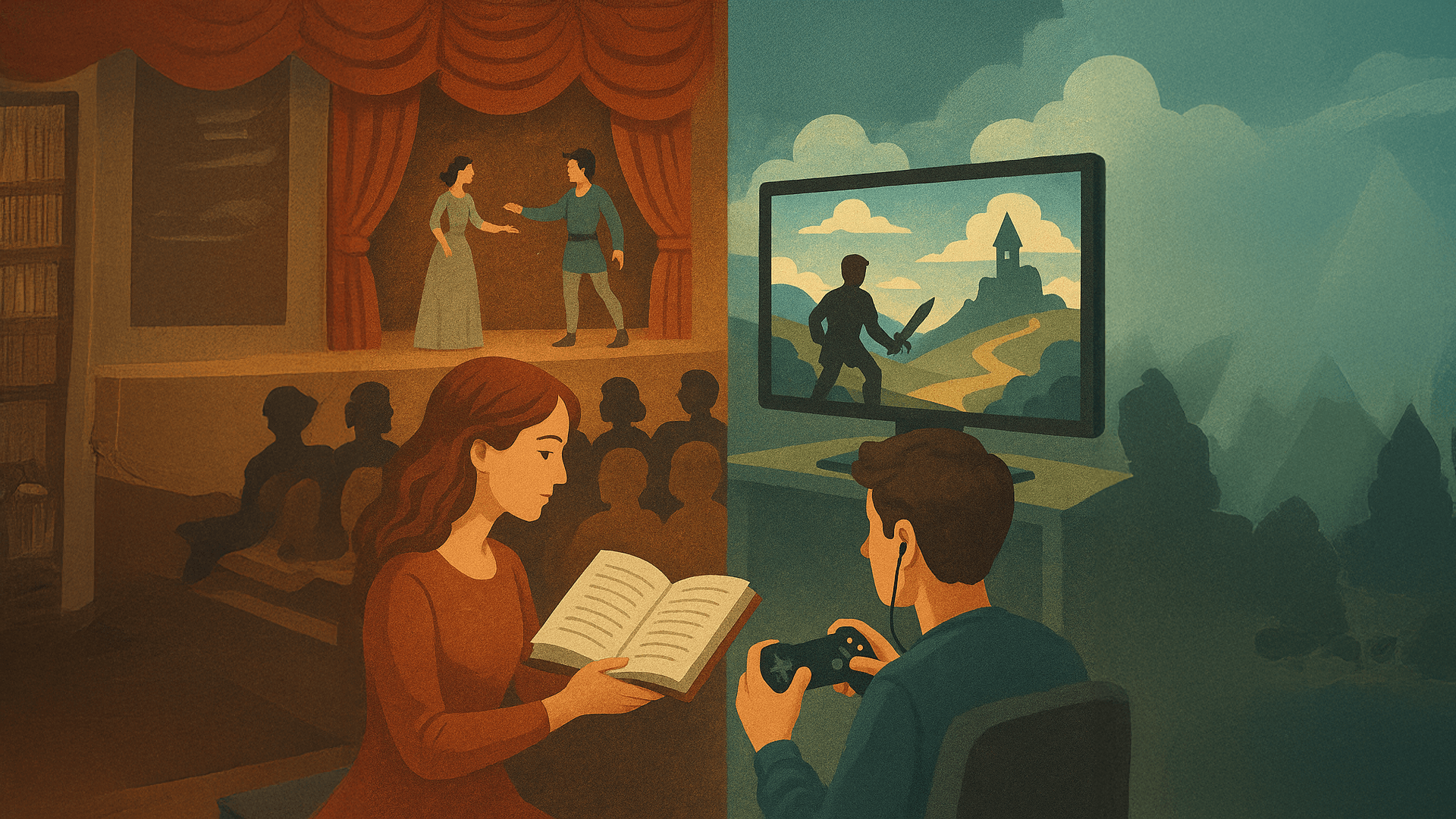
The Narrative Threshold: Literature at Virtual Narrative Exploring the Flow of Traditional Storytelling in the Age of Interactivity
The question of whether art, as a visual narrative, has influenced textual storytelling or vice versa has been debated for centuries. However, regardless of which came first, we now find ourselves immersed in a compelling offspring of both: an interactive and immersive form of narration through video games. Unlike other intersections of visual and textual narrative—such as comic books, film, or theatre—this medium introduces a fundamental shift: whereas those experiences are generally passive, the act of playing is overtly active. This distinction is key, for video games do not just present a story to the audience; they invite them to become a part of it. That said, no medium fits neatly into a single category. This discussion centers on narrative-driven games, deliberately setting aside those that prioritize kinesthetic engagement—like running, jumping, or combat mechanics—focusing instead on those where storytelling is the primary draw.
It is important to note that interactive engagement in storytelling is not entirely new. Interactive traditions have long existed, most notably in certain forms of theatre. Shakespearean drama, for instance, often involved audience engagement that blurred the lines between observer and participant. The "groundlings" in Shakespeare’s time would cheer, jeer, and directly respond to the action on stage, at times even shaping performances. This involvement of the audience in shaping the narrative experience harkens back to an era when storytelling was not a one-way transmission of information but a dynamic interaction. This sense of communal participation, though somewhat diminished in modern performances, still speaks to the enduring desire for a participatory mode of storytelling.
Another prominent figure, much closer to our era, is Bertolt Brecht. His epic theatre further challenged passive spectatorship by deliberately alienating the audience in order to provoke critical detachment and social reflection. Techniques such as breaking the fourth wall, direct address, and narrative interruption were all intended to remind viewers of their role as thinking participants rather than mere consumers of narrative. Brecht’s work can be seen as a precursor to the kind of self-aware, interactive storytelling present in modern video games—where the lines between creator and audience blur, and the audience's engagement with the story is not only expected but essential.
While these literary and theatrical traditions do not grant the same narrative agency found in story-rich RPGs, they reveal a shared desire: to destabilize passive storytelling and invite audiences into more participatory roles. As Eric Hayot argues, this shift is not a sudden invention of the digital age but part of a longer historical continuum within human storytelling practices, stretching back to ancient oral traditions where listeners were often active participants in the telling of stories. This participatory impulse has simply found new forms of expression in the modern age, with digital technology enabling a level of interactivity previously unimaginable.
Examining titles such as The Pathfinder series, Warhammer 40K: Rogue Trader, or the recent Baldur’s Gate 3, one sees clear parallels with epic literary traditions. These games frequently adopt the structure of the hero’s journey, echoing works like The Lord of the Rings or even its supposed predecessor, Beowulf. The immersive storytelling in these games—and others like them—almost borders the narrative and character depth of their literary counterparts. Yet, they also enrich the experience further: through player choice and branching storylines, these games enable users to actively shape the narrative, making them not mere observers but co-creators of the story world. The landscape itself becomes something players can alter, their actions reverberating through the world and the characters within it, fostering a sense of agency that traditional forms of storytelling can not always afford.
Therefore, the narrative is fluid, shaped by decisions, actions, and responses. Critics may argue that video game narratives often rely on familiar tropes or lack the literary subtlety found in classic literature, but this criticism overlooks the evolving complexity and emotional depth of modern game writing. Far from being a simplistic or shallow medium, video games are increasingly capable of delivering stories that explore profound themes of identity, morality, loss, and redemption, much like their literary and theatrical predecessors. The dialogue between player and game deepens as well, offering moments of introspection and moral dilemma that could mirror the best works of fiction.
Narrative-driven video games, then, are not a break from literary and theatrical tradition but their continuation and transformation. As digital storytelling evolves, it does not discard the past—it builds on it, reconfiguring the roles of audience and creator. In this light, video games become a vibrant site where storytelling is not only experienced but enacted. The debate over which medium came first fades in importance; what endures is the adaptability of narrative discourse itself, now infused with agency and shaped by the very hands that engage with it. In fact, we may go even further and argue that video games may well offer the most contemporary version of the narrative threshold—a space where the traditional roles of storyteller and audience can coexist, intertwine, and mutually shape a shared experience. Far from reducing the power of narrative, video games serve to amplify it, presenting new forms of engagement that challenge and enrich our understanding of what storytelling can be.
Thus, the future of storytelling is not one of linearity but of multiplicity. The narrative, far from being a fixed entity, becomes something fluid, subject to the whims of those who engage with it. The world of interactive storytelling in video games offers an exciting frontier where traditional forms of narrative continue to evolve, bridging the gap between observer and participant, reader and writer, past and present.
References:
Hayot, Eric. “Video Games & the Novel.” Daedalus, vol. 150, no. 1, 2021, pp. 178–87. JSTOR, https://www.jstor.org/stable/48609832. Accessed 22 Apr. 2025.
By Naz Arslan




